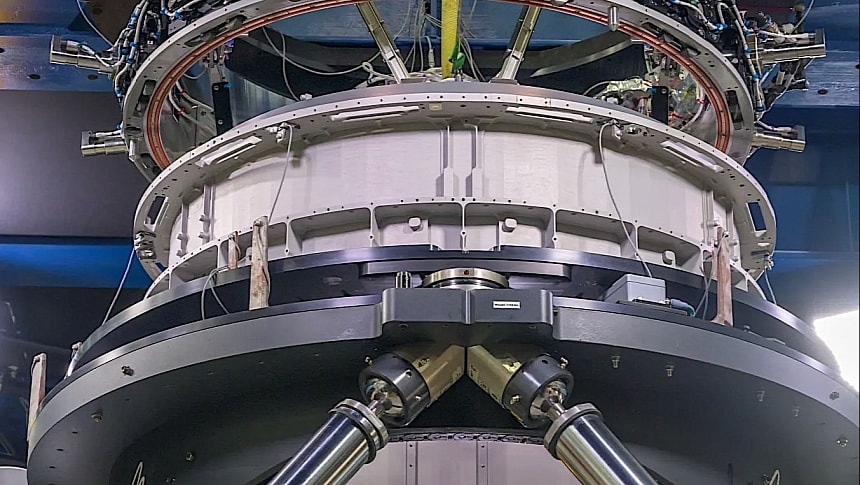At the beginning of the year American space agency NASA announced the postponement of the Artemis II mission, pushing it from late 2024 to late 2025. As a result the Artemis III flight, which will actually place American boots on the surface of the Moon, is now scheduled for 2026.
NASA did not specifically name the reasons for the move, limiting itself to saying it is all in the best interest and safety of the astronauts that will travel in the Orion spacecraft during the two missions. The unnamed elephant in the room is of course the fact that the technologies needed for the missions are not nearly ready.
That includes the Starship Human Landing System (HLS), the piece of tech that actually takes the crew of Artemis III from their spacecraft in lunar orbit down to the surface. Several years after NASA awarded the contract for the tech's development to SpaceX, we're yet to see the full vehicle, or learn more about its capabilities. And that despite the space agency claiming it had "completed more than 30 HLS specific milestones."
The scarce bits of info concerning the HLS culminated in December 2023 with news of the elevator that will move cargo and crew from inside the lander's habitable area to the surface of the Moon being put through its paces.
It's been three months since then, and we have only now received another update on the HLS. Ok, maybe not on the HLS itself, but on the docking system that will link the Orion spacecraft to the lander.
The Artemis III mission profile calls for the Orion to enter a lunar orbit and send people down to the surface of the Moon in the lander. Once their work down there is complete, the crew will take the lander up to link with the spacecraft and make the trip home.
For that to happen the lander and spacecraft must connect somehow, and the way they will do that is through a docking system. Derived from the similar piece of tech used by SpaceX to dock its Dragon spacecraft to the International Space Station (ISS), the system is crucial to the success of the mission.
We learned at the end of February that NASA and SpaceX completed a series of qualification tests for the docking system. The procedures took place at the Johnson Space Center over a period of ten days, and relied on simulated "contact dynamics between two spacecraft in orbit."
In all some 200 docking scenarios were practiced, each of them using various approach angles and speeds, and the results will be used by the two partners to "validate computer models of the Moon lander's docking system."
The results of the test seem to be encouraging, as the space agency says it has proven the docking system can perform a soft capture.
It's unclear at this point exactly when the tech will be declared fit for duty, but given how NASA won't be needing it before 2026 there's still some waiting to be done.
That includes the Starship Human Landing System (HLS), the piece of tech that actually takes the crew of Artemis III from their spacecraft in lunar orbit down to the surface. Several years after NASA awarded the contract for the tech's development to SpaceX, we're yet to see the full vehicle, or learn more about its capabilities. And that despite the space agency claiming it had "completed more than 30 HLS specific milestones."
The scarce bits of info concerning the HLS culminated in December 2023 with news of the elevator that will move cargo and crew from inside the lander's habitable area to the surface of the Moon being put through its paces.
It's been three months since then, and we have only now received another update on the HLS. Ok, maybe not on the HLS itself, but on the docking system that will link the Orion spacecraft to the lander.
The Artemis III mission profile calls for the Orion to enter a lunar orbit and send people down to the surface of the Moon in the lander. Once their work down there is complete, the crew will take the lander up to link with the spacecraft and make the trip home.
For that to happen the lander and spacecraft must connect somehow, and the way they will do that is through a docking system. Derived from the similar piece of tech used by SpaceX to dock its Dragon spacecraft to the International Space Station (ISS), the system is crucial to the success of the mission.
We learned at the end of February that NASA and SpaceX completed a series of qualification tests for the docking system. The procedures took place at the Johnson Space Center over a period of ten days, and relied on simulated "contact dynamics between two spacecraft in orbit."
In all some 200 docking scenarios were practiced, each of them using various approach angles and speeds, and the results will be used by the two partners to "validate computer models of the Moon lander's docking system."
The results of the test seem to be encouraging, as the space agency says it has proven the docking system can perform a soft capture.
It's unclear at this point exactly when the tech will be declared fit for duty, but given how NASA won't be needing it before 2026 there's still some waiting to be done.














